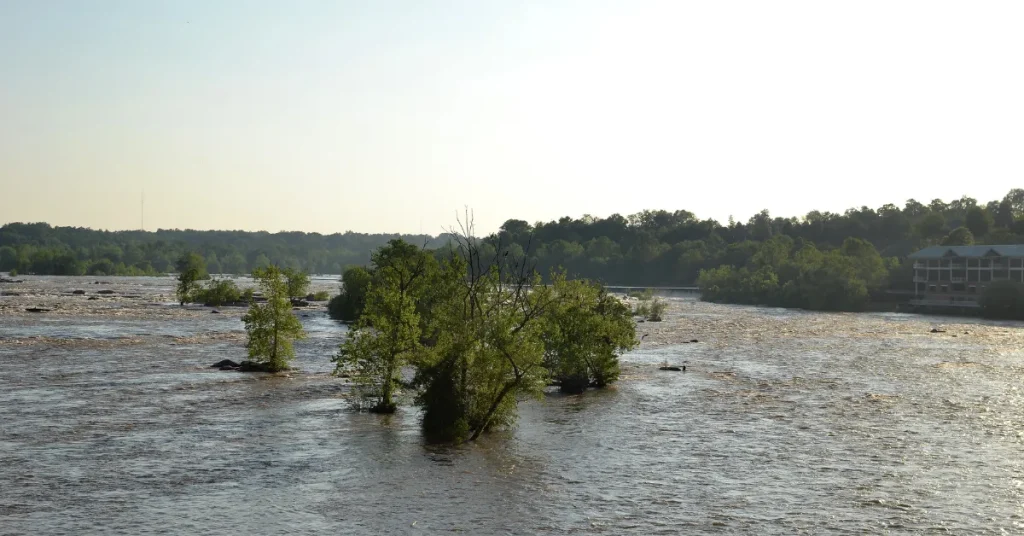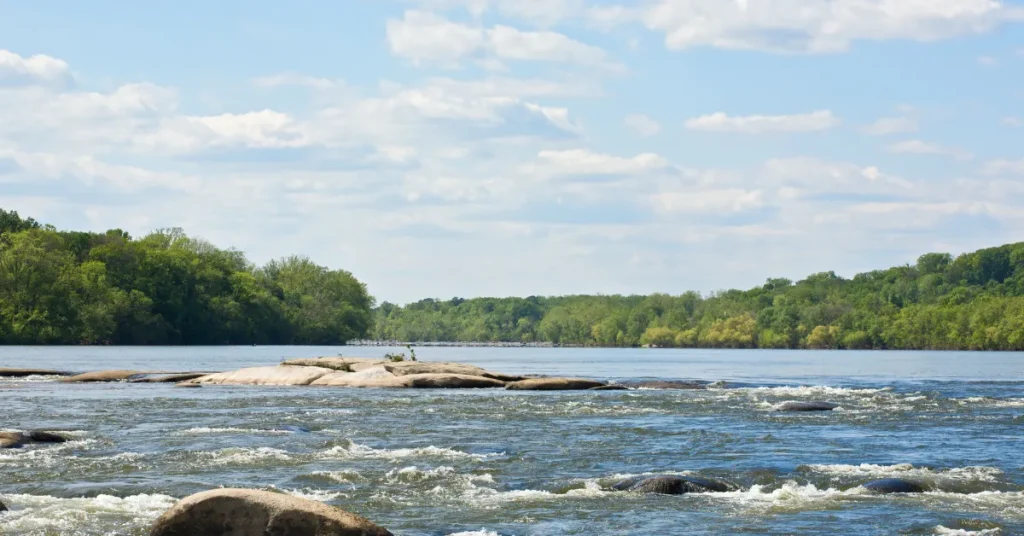The James River depth varies, but it can reach depths of over 100 feet at certain points. Its average depth ranges from 4 to 20 feet.
The James River flows majestically through Virginia, serving as a historical and ecological treasure. Originating from the Appalachian Mountains, this river stretches approximately 348 miles to meet the Chesapeake Bay.
It presents a diverse range of recreational activities, including fishing, boating, and swimming, catering to outdoor enthusiasts of all kinds.
Its shores are lined with various ecosystems, from freshwater marshes to dense forests, supporting an abundance of wildlife. The James River also plays a crucial economic role, connecting communities and industries with its navigable waters.
Through proactive conservation efforts, the health of this river remains a top priority, ensuring it continues to be a vital resource for generations to come.

The James River Depths Revealed
The James River twists through Virginia, offering a glimpse into the heart of its diverse landscapes. From shallow ripples to mysterious depths, this river holds secrets beneath its surface.
Explorers and enthusiasts alike marvel at the varying depths of this waterway. Embark on a journey to uncover how deep the James River runs and what mysteries it conceals.
Varied Depths Along Its Journey
The James River showcases a dynamic range of depths as it travels across Virginia. In its upper reaches, the river treats visitors to gentle shallows perfect for wading and wildlife watching.
As it meanders downstream, depth fluctuations create a rich habitat for various species. Outdoor adventurers find these shifts ideal for different activities, from kayaking to fishing.
- Mountain regions: Often shallow, ideal for rafting and rock hopping.
- Piedmont areas: Moderate depths, offering great spots for swimming.
- Coastal plains: Depths increase, widening the river for boating and commerce.
Deepest Points And What Lies Beneath
As the James River approaches its final descent towards the Chesapeake Bay, its depths reach their zenith.
Near the Jamestown Island and the James River Bridge, divers can explore depths up to 25 feet. These areas, often steeped in history, shelter diverse aquatic life and remnants of human history.
| Location | Approximate Depth | Features |
| Jamestown Island | 20-25 feet | Historic artifacts, marine life |
| James River Bridge | Up to 25 feet | Shipwrecks, fish species |
At these depths, the river houses sunken boats, aquatic plants, and a myriad of fish species. For the curious and brave, there’s much to discover in the river’s deeper segments.
James River‘s Profile: From Source To Sea

A journey across diverse terrains, the James River unfolds its remarkable course from its unassuming origins to its grand confluence with the Atlantic.
From Source to Sea, the river paints a dynamic portrait of nature’s waterways, each stretch presenting its own depth and narrative.
Headwaters And The Gentle Beginnings
The nascent streams that form the James River emerge quietly in the Appalachian Mountains.
These headwaters, often shallow, ripple gently over a rocky bed. Here, the river’s depth can be as little as a few inches, accessible to wandering wildlife and reflecting the clear Virginia sky.
Transitioning Through Landscapes
As it threads through valleys and forests, the river’s character molds to the land. In piedmont regions, the depth steadily increases.
The James River cuts a deeper path, navigating around sediment and rock, fluid in its quest for the sea. By the time it reaches Richmond, depths can average 12 to 25 feet.
- Min Depth in Piedmont: 3 feet
- Max Depth near Cities: 25 feet
Confluence And The Surge To The Ocean
The final run toward the ocean witnesses the meeting of tributaries. Waters mix and the river swells.
Depths can reach up to 100 feet, with the strongest surge felt as the James greets the Chesapeake Bay. Here, the river fully embraces its role as a maritime highway, supporting ships and teeming with life.
| Location | Depth (feet) |
| Confluence with Chesapeake Bay | Up to 100 |
The Ecological Significance Of Depth Variation
The James River snakes through Virginia with a depth that holds ecological treasures. Variations in this river’s depth create an array of habitats for diverse species, each contributing uniquely to the river’s health and resilience.
The depth of the river not only shapes its character but is also essential for sustaining the rich biodiversity it supports.
Habitats Defined By Water Depth
- Shallow zones: Home to juvenile fish and amphibians.
- Mid-depth areas: Provide shelter and food for a variety of fish.
- Deep pockets: Support species needing cooler and darker environments.
Impact Of Depth On River Health
Depth variation in the James River contributes to a healthy ecosystem. Deep waters are crucial for temperature control, ensuring survival for temperature-sensitive species.
Shallow areas let sunlight reach aquatic plants, fueling the food web. Together, these depth changes keep the river’s ecosystems balanced and flourishing.
Species That Thrive In The James River Depths
| Depth Range | Species |
| 0-3 feet | American Shad, Sunfish |
| 3-12 feet | Channel Catfish, Smallmouth Bass |
| Over 12 feet | Atlantic Sturgeon, Flathead Catfish |
Each depth level of the James River is a world of its own, teeming with life forms perfectly adapted to their aquatic niches. By supporting a vast range of species, the river’s depth variations play a key role in its ecological dynamics.
Historical And Cultural Tales From The Depths
The James River, a jewel in Virginia’s crown, is not just a body of water. Its depths hold secrets that whisper of America’s past and carry tales of the daring and the long-forgotten.
James River In American History
The James River wears many historical hats. It served as a critical transport route during the Civil War and the Revolutionary War. Here, whispers of independence flowed as freely as its currents.
- Frozen in time: Colonial settlements dotted along its banks.
- The first legislature: Jamestown, on its banks, birthplace of American government.
- Freedom’s battleground: The river, a silent witness to harrowing Civil War stories.
Maritime Lore And The Depths
Tales of nautical adventures and misadventures color the history of the James River. Shipwrecks and sunken treasures are rumored to nest at the riverbed, a silent hymn to its maritime heritage.
Hidden below:
Ghost ships and age-old shipwrecks promising secrets and stories.
Archaeological Finds Beneath The Waves
Archaeologists diving into its depths have surfaced with artifacts that speak volumes about bygone eras. These discoveries paint a picture of early Native American civilizations and colonial life in Virginia.
| Artifact | Era | Significance |
| Pottery shards | Pre-colonial | Insight into Native American daily life |
| Colonial coins | 17th Century | Evidence of trade and economy |
| Musket balls | Revolutionary War | Remnants of early American conflicts |
Exploring The Depths: Human Endeavors And Technology

Embarking on a journey to uncover the depths of the James River reveals a treasure trove of human endeavors intertwined with cutting-edge technology.
This storied river has captured the imaginations of adventurers and scientists alike. Let’s dive deep to uncover what lies beneath the surface of one of America’s oldest rivers.
Recreational Use And The River’s Depths
The James River, a playground for water enthusiasts, holds secrets beneath its ripples. Kayakers and anglers often wonder about its depth. Depth impacts their experiences in different ways.
Kayakers look for shallow areas for safety. Anglers seek deeper parts for the big catch. The river offers both, with depths ranging from a few feet in sections to over 100 feet in deeper channels.
- James River Park System in Richmond – shallow rapids ideal for kayaking.
- Bremo Bluff near the nuclear power plant – some of the deepest points.
Technological Advances In Depth Measurement
Technologies have evolved from rudimentary lead lines to sophisticated sonar instruments. Gone are the days of mere guesswork.
Modern sonar equipment now charts the riverbed with precision, providing detailed maps of the river’s depths. Advent of GPS technologies further refines these depth charts, aiding in navigation and research.
| Technology | Use |
| Echo sounding | Measures depth using sound waves. |
| GPS mapping | Creates detailed depth charts. |
Conservation Efforts Leveraging Depth Information
Conservationists utilize depth data to protect the river’s ecosystem. Information about the depths informs where to plant vegetation and how to manage habitats for fish and wildlife. Initiatives enhance water quality and preserve the river’s rich biodiversity.
- Planting aquatic grasses in shallower areas.
- Designating conservation areas based on depth data.
Accurate depth knowledge allows for tailored environmental action plans. These plans ensure the James River remains a vital resource for future generations.
FAQs About How Deep Is The James River
What Is The Average Depth Of The James River?
The James River has an average depth of about 6 to 8 feet. However, this can vary significantly depending on the specific area and current weather conditions. Depths may exceed 100 feet in certain deep channels.
How Deep Is The James River At Its Deepest Point?
At its deepest point, the James River reaches depths of approximately 100 feet or more. This is often found in the river’s shipping channels near the mouth at Hampton Roads.
Where Is The James River Shallowest?
The James River is shallowest along its upper reaches, particularly near the headwaters in the Appalachian Mountains. In some spots here, it can be just a few inches deep during low water conditions.
Does The James River Depth Vary Seasonally?
Yes, the James River’s depth can fluctuate seasonally. Spring thaws and heavy rains often lead to higher water levels, while dry spells can significantly reduce the river’s depth, particularly during the summer and early fall months.
Conclusion
Exploring the depths of the James River unveils a fascinating journey. From its shallowest ripple to its deepest trench, the river varies greatly, averaging a depth of 20-25 feet.
Remember, these waters hold stories centuries old, beckoning adventurers and historians alike.
Embark on your own discovery, diving into the rich narrative the James River offers.
Resources:
1. https://www.dcr.virginia.gov/state-parks/james-river
